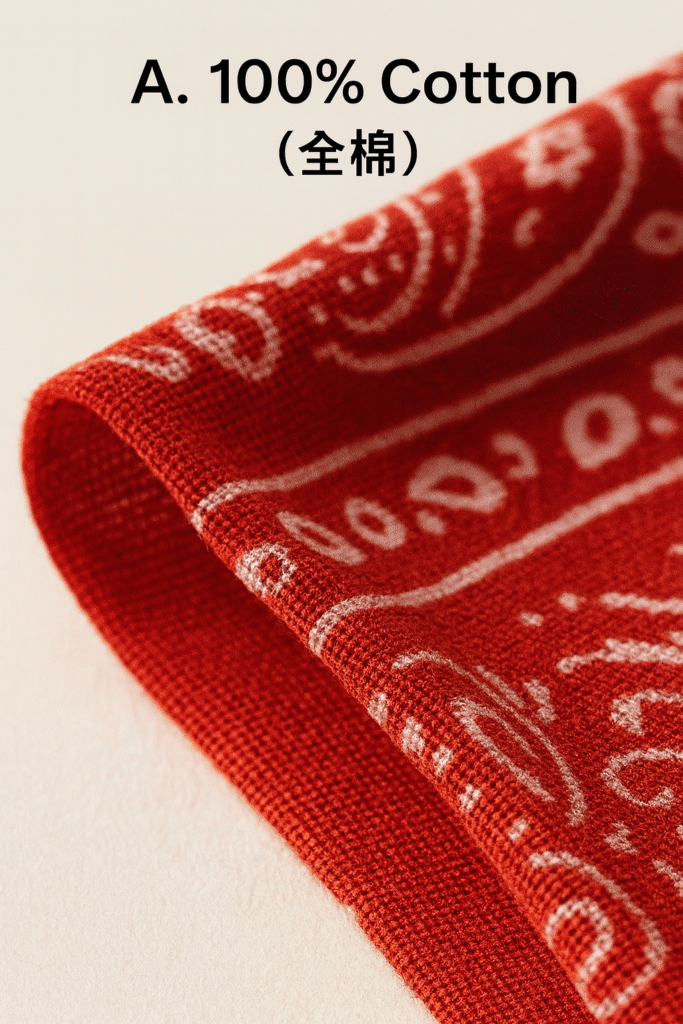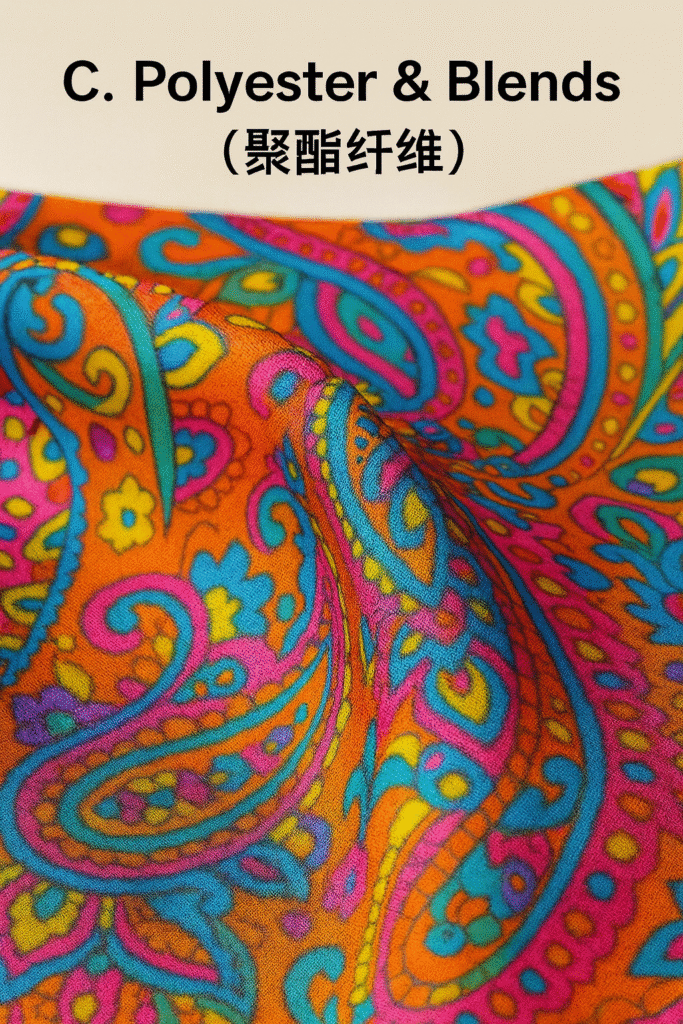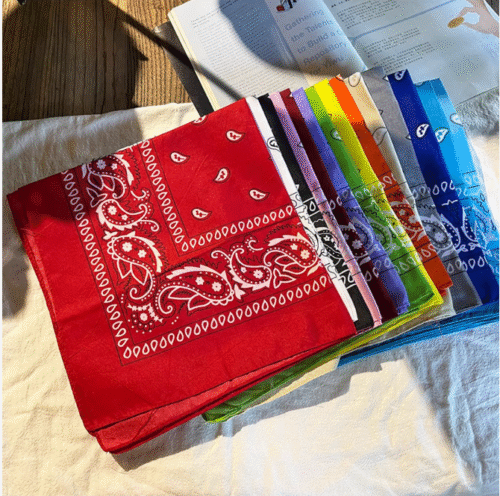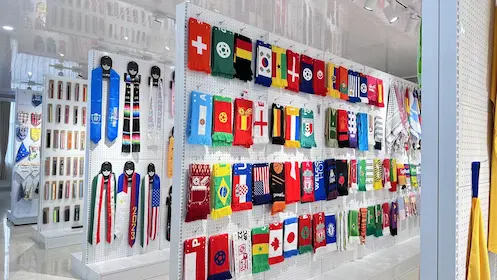Subtitle: Ever wonder why some square silk scarf get softer with every wash, while others just fall apart? This guide breaks down the different types of bandanas to help you find the perfect one.
Are you trying to buy a pañuelo but feel totally lost in the options?
They all look kinda the same—a square piece of cloth, usually with that classic bandana Paisley print. But here’s the truth: there is a massive difference between a $5 promo bandana and a $50 Japanese selvedge bandana.
When users search for “types of bandanas,” what they’re really asking is, “Which one should I buy?” and “What’s the actual difference between all these?”
As experts in textiles and accessories, we wrote this guide to give you real, trustworthy answers. We’re skipping the surface stuff and getting right to what really makes a bandana good or bad: Fabric, Construction, and its Use Case.

01. It All Starts with Fabric: The Most Important Way to Classify Bandanas
Of all the ways to categorize them, fabric is the most important. It’s what really answers the user’s questions. Fabric directly controls a bandana’s feel, durability, absorbency, look, and price.
A. 100% Cotton
This is the most traditional, classic bandana fabric. It’s the top choice for workwear and vintage fans.
- Expert Take: The whole point of a high-quality cotton bandana is how it “breaks in.” A premium cotton bandana (like those Made in USA or Japan) is often very stiff right out of the package. This is because of the starch used in the printing process.
- Real-World Experience: A lot of people get a new workwear bandana and are disappointed, thinking it feels like “sandpaper.” But that’s the point. After a few washes and some use, the cotton fibers relax, the color fades naturally (especially with discharge printing), and it becomes incredibly soft, and super absorbent.
- Best for: Anyone who values durability, classic style, or needs high absorbency (for wiping sweat, cleaning tools, etc.).
- Keywords: Classic Cotton, Durable, Absorbente, Softens with age.

B. Silk
Silk is the luxury type of bandana, most often seen from high-end fashion brands.
- Expert Take: Silk’s advantage is its unbeatable shine and softness. It’s great for your skin and hair, as it doesn’t cause static or friction.
- Real-World Experience: High-fashion houses (like Hermès) use silk scarves as a variation of the bandana. For everyday life, a silk bandana is mostly a style choice—worn as a neckerchief, hair tie, or bag accessory, it instantly makes an outfit look more polished.
- Best for: Fashion lovers, anyone seeking an ultra-soft feel, or those using it to protect their hair.
- Keywords: Bandana de seda, Luxury, Softness, Fashion Accessory.

C. Polyester & Blends
This is the go-to for modern functional bandanas and low-cost pañuelos personalizados.
- Expert Take: The biggest pros for polyester are bright colors that don’t fade and a low price. It’s perfect for printing complex, colorful print bandanas using sublimation. It’s also quick-drying and wrinkle-resistant.
- Real-World Experience: Mayoría promotional bandanas or any bandana with a logo on it are poly or a cotton-poly blend. Also, the tube-style “magic headwear” (Neck Gaiters) used for sports are almost always a functional polyester for moisture-wicking.
- Best for: Sports, team customization, event giveaways, or anyone on a budget who wants a sharp, vibrant print.
- Keywords: Poliéster, Colores vibrantes, Moisture-wicking, Impresión personalizada.

02. How to Spot Quality: It’s All in the Edge
(A pro-level perspective, courtesy of Heddels)
Two bandanas might use the same fabric, but the construction can create a huge quality gap. Here’s a pro tip: Check the edge.
- Selvedge – Top-Tier: This is the ultimate sign of quality. “Selvedge” means two of the bandana’s edges are the fabric’s own woven “self-edge” (made on an old-school shuttle loom). It will never unravel. The other two sides are finished with a single stitch. This is the fastest way to spot a premium bandana.
- Hemmed/Stitched – Standard: This is the most common finish you’ll find on a quality bandana today. All four edges are rolled inward and fixed with a line of stitching. A well-done hem is also very durable.
- Overlocked/Merrowed – Economy: This uses a special machine to quickly “zip” the edge with thread. This process is fast and cheap, but it’s not as tough as a hemmed edge. You’ll see this on lower-end or polyester bandanas.
03. Why Are You Buying It? The Types of Bandanas by Purpose
Finally, your “why” also determines the type of bandana you need.
A. The Workwear / Heritage Bandana
- What it is: 100% heavy cotton, Made in USA/Japan, Selvedge details, classic Paisley or Hav-A-Hank style print.
- Use it for: Real-world daily use, wiping sweat, blocking wind, raw-denim and heritage-style outfits. This is the bandana you “break in.”
B. The Fashion Bandana
- What it is: Varied materials (seda, fine cotton, rayon), designer prints, custom print bandanas.
- Use it for: Purely as a style accent. Tied on a wrist, around the neck, in your hair, or on a bag.
C. The Functional / Promotional Bandana
- What it is: Poliéster, tube-style (Neck Gaiter), printed with a bandana with logo, low cost.
- Use it for: Outdoor sports (sun/dust protection), team events, music festivals, corporate giveaways.
Summary: How to Choose Your Perfect Bandana
Let’s solve your original problem: “Which one should I buy?”
- If you want durability, a classic vibe, and something that ‘breaks in’ with you: Go for 100% Cotton, and look for a Workwear Bandana made in the USA or with a Selvedge edge. Be patient and wash it. It will get soft.
- If you need a fashion accessory to look more polished and refined: Choose Seda or a high-quality, fine-cotton Bandana de moda. Focus on the print design and softness.
- If it’s for sports, the outdoors, or you need a large custom order: Poliéster or a poly-blend is your best bet. It gives you bright, sharp Custom Prints, offers moisture-wicking functions, and is budget-friendly.
By understanding the very real differences in fabric and learning how to check the edge construction, you now know more than most shoppers and can confidently pick the exact type of bandana you actually need.
FAQs
Q: Why is my new 100% cotton bandana so stiff and scratchy? A: That’s actually a good sign! High-quality cotton workwear bandanas use starch to keep them stiff for the printing process. It’s meant to be stiff at first. Just wash it a few times, and it will become incredibly soft.
Q: What’s the best bandana for working out or hiking? A: A poliéster bandana or a seamless neck gaiter (tube style). They are lightweight and designed for moisture-wicking, pulling sweat away from your skin to keep you dry.
Q: How can I quickly tell if a bandana is high-quality? A: Look at the edge. The highest quality is a “Selvedge” edge (a clean, woven edge that can’t unravel). The next best is a neatly “Hemmed” or stitched-down edge. Avoid ones with a loose “Overlocked” thread, as they fray easily.
Q: Is silk or cotton better for hair? A: Seda is better for protecting hair. Its smooth surface reduces friction and static, which helps prevent breakage and frizz.



